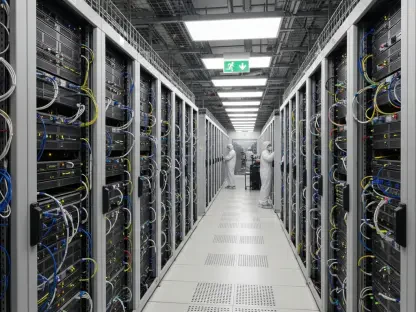Imagine a world where even the smallest startup can harness the power of cutting-edge AI without the burden of million-dollar hardware investments. This vision is becoming a reality as the AI training sector undergoes a seismic shift, driven by innovative platforms that prioritize accessibility and scalability. CoreWeave, a key player in the GPU-as-a-Service market, has launched an ambitious serverless platform tailored for reinforcement learning (RL), setting a new benchmark for how businesses approach AI development. This report delves into the evolving landscape of AI infrastructure, examines CoreWeave’s groundbreaking offering, and explores the challenges and opportunities shaping this dynamic industry.
The AI Training Landscape: Context and Importance
Industry Overview and Key Players
The AI training sector is experiencing unprecedented growth, fueled by soaring demand for accessible, high-performance computing resources. GPU-as-a-Service providers have emerged as critical enablers, offering cloud-based solutions that eliminate the need for companies to build and maintain their own infrastructure. This model caters to a broad spectrum of businesses, from tech giants to emerging startups, all seeking to leverage AI for competitive advantage.
CoreWeave stands out among these providers, carving a niche with specialized GPU clusters designed for intensive AI workloads. Competing alongside industry heavyweights like Google, IBM, and Microsoft, the company benefits from strategic partnerships that enhance its market presence. However, these collaborations also underscore the competitive intensity of a sector where innovation and reliability are paramount to maintaining client trust.
Beyond individual players, the market is shaped by a growing emphasis on democratizing AI tools. As more industries integrate AI into their operations, the need for flexible, cost-effective infrastructure continues to escalate, pushing providers to rethink traditional computing paradigms and prioritize user-friendly solutions.
Technological Trends and Market Drivers
Reinforcement learning, a subset of machine learning where algorithms learn through trial and error, has gained traction as a powerful method for developing adaptive AI systems. Coupled with serverless computing, which abstracts infrastructure management from users, RL is transforming how models are trained, offering unparalleled flexibility for developers working on complex applications.
Market dynamics are also shifting toward scalable, budget-conscious solutions as businesses seek to optimize costs without sacrificing performance. This trend is driven by consumer demand for sophisticated AI applications, from personalized recommendations to autonomous systems, which require robust training environments that can handle massive datasets efficiently.
Additionally, the push for sustainability in tech is influencing infrastructure design, with providers exploring energy-efficient GPU architectures to meet both performance and environmental goals. These converging forces highlight the urgency for platforms that balance innovation with practicality, setting the stage for disruptive advancements in AI training methodologies.
CoreWeave’s Serverless RL Platform: A Game-Changer
Features and Innovations
At the heart of CoreWeave’s new offering is a serverless architecture specifically engineered for reinforcement learning tasks. This platform automates workload distribution across GPU clusters, ensuring optimal resource utilization and minimizing downtime for users. Such efficiency is critical for stateless AI applications, where temporary data storage is unnecessary, allowing seamless training cycles without manual oversight.
Integration with tools like OpenPipe and Weights & Biases further enhances the platform’s appeal. These partnerships enable streamlined model optimization, providing developers with real-time insights and fine-tuning capabilities directly within the serverless environment. This cohesive ecosystem reduces complexity, empowering teams to focus on innovation rather than infrastructure management.
The emphasis on user experience is evident in the platform’s design, which prioritizes simplicity while maintaining high-performance standards. By abstracting technical intricacies, CoreWeave is positioning itself as a go-to solution for organizations aiming to accelerate AI deployment across diverse use cases.
Cost Efficiency and Accessibility
One of the standout aspects of this platform is its token-based pricing model, a departure from traditional subscription or usage fees. By charging solely for tokens generated during model fine-tuning, CoreWeave lowers the financial entry barrier, making advanced AI training feasible for smaller enterprises and startups with limited budgets.
This approach not only broadens market reach but also aligns with the industry’s move toward inclusivity in technology adoption. Businesses can now experiment with RL models without committing to hefty upfront costs, fostering a culture of innovation among diverse players who might otherwise be excluded from such capabilities.
Moreover, the scalability inherent in a serverless framework ensures that costs remain proportional to usage, offering predictability and transparency. This financial flexibility is poised to reshape how organizations allocate resources for AI initiatives, potentially leveling the playing field in a historically capital-intensive domain.
Challenges in CoreWeave’s Expansion
Operational and Partnership Issues
Despite its technological strides, CoreWeave faces significant hurdles in maintaining operational consistency. Reports of missed deadlines and delivery shortcomings have strained relationships with key partners, including a notable fallout with Microsoft that resulted in terminated agreements. Such setbacks carry substantial financial and reputational consequences.
The loss of potential billion-dollar contracts underscores the fragility of client trust in a sector where reliability is non-negotiable. For a company aiming to expand its footprint, these incidents highlight the need for robust internal processes to ensure commitments are met consistently across all engagements.
Addressing these challenges requires a strategic overhaul of project management and communication frameworks. Without swift corrective measures, CoreWeave risks alienating existing clients and deterring prospective ones, which could hinder its long-term growth trajectory in a highly competitive market.
Hardware Dependency Risks
CoreWeave’s infrastructure heavily relies on Nvidia hardware, leveraging advanced architectures like InfiniBand to deliver top-tier performance for AI workloads. While this dependency ensures cutting-edge capabilities, it also exposes the company to risks associated with supply chain disruptions or shifts in supplier priorities.
A single-supplier model can become a liability if geopolitical tensions or manufacturing constraints limit access to critical components. Such vulnerabilities could disrupt service delivery, impacting clients who depend on uninterrupted access to GPU resources for their operations.
Mitigating these risks necessitates exploring alternative hardware options or establishing contingency plans to buffer against potential shortages. Diversifying supplier relationships could provide a safeguard, ensuring that CoreWeave remains agile in the face of unforeseen industry challenges.
Strategic Moves and Regulatory Considerations
Diversification Through Acquisitions
In a bid to expand its scope, CoreWeave recently acquired Monolith AI, a firm specializing in AI-driven simulations for physics and engineering applications. This acquisition marks a deliberate step toward penetrating niche markets, broadening the company’s portfolio beyond general AI training into highly specialized infrastructure solutions.
Such strategic moves aim to reduce reliance on a concentrated client base, a concern highlighted in recent financial disclosures showing significant revenue dependency on just a few major accounts. By diversifying offerings, CoreWeave seeks to stabilize income streams and appeal to a wider array of industries with unique computational needs.
This expansion also positions the company to tap into emerging sectors where AI intersects with real-world problem-solving, potentially creating new revenue channels. However, integrating acquired entities poses its own set of challenges, requiring careful alignment of technologies and corporate cultures to maximize value.
Compliance and Market Standards
Navigating the regulatory landscape remains a critical aspect of CoreWeave’s operations, particularly as data privacy and security standards tighten globally. Cloud-based AI solutions must adhere to stringent guidelines to protect sensitive information, a factor that influences both platform design and customer confidence.
Compliance with evolving regulations, such as those governing cross-border data transfers, demands proactive investment in security protocols and transparent practices. Failure to meet these standards could result in legal repercussions or loss of market credibility, especially for clients in regulated industries like healthcare or finance.
Balancing innovation with regulatory obligations is a delicate task, yet it is essential for sustaining trust in serverless platforms. CoreWeave must prioritize frameworks that not only meet current requirements but also anticipate future shifts in policy to maintain a competitive edge.
Future Outlook for CoreWeave and AI Training
Emerging Opportunities and Innovations
Serverless RL platforms and GPU-as-a-Service models are set to redefine AI accessibility, enabling a broader range of organizations to participate in technological advancement. As these solutions mature, they could unlock novel applications in areas like autonomous systems, personalized healthcare, and predictive analytics, driving further market expansion.
Potential disruptors, such as breakthroughs in alternative hardware or rival platforms offering comparable services at lower costs, loom on the horizon. These developments challenge CoreWeave to continuously innovate, ensuring its offerings remain distinct in a crowded field of competitors pushing similar boundaries.
Additionally, collaborations with academic institutions and research bodies could spur advancements in RL methodologies, creating synergies that benefit both practical applications and theoretical progress. Staying ahead of these trends will be crucial for maintaining relevance in an ever-evolving ecosystem.
Growth Factors and Economic Influences
Global economic conditions play a pivotal role in shaping AI investment, with fluctuations in funding availability impacting how quickly businesses adopt advanced training solutions. In periods of economic uncertainty, cost-effective platforms like CoreWeave’s may see heightened demand as companies prioritize efficiency over expansive in-house setups.
Conversely, robust economic growth could accelerate adoption by freeing up capital for tech initiatives, benefiting providers with scalable, performance-driven infrastructure. CoreWeave’s focus on delivering high-value, low-overhead solutions positions it favorably to capitalize on such cycles, provided operational issues are resolved.
Geopolitical stability and trade policies also influence hardware availability and pricing, indirectly affecting the GPU-as-a-Service market. Monitoring these macro factors will be essential for anticipating shifts in demand and adjusting strategies to sustain growth over the coming years.
Conclusion: Balancing Innovation and Risk
Reflecting on CoreWeave’s journey, the launch of its serverless RL platform stands as a bold move to reshape AI training accessibility, addressing a critical need for scalable, cost-effective solutions. The integration of advanced technologies and strategic acquisitions like Monolith AI showcases a commitment to versatility, even as operational missteps with partners cast shadows on reliability.
Looking back, the dual narrative of innovation and risk underscores the complexity of rapid expansion in a competitive, hardware-dependent industry. Challenges with client relationships and supplier reliance reveal areas needing urgent attention to prevent long-term setbacks.
Moving forward, CoreWeave could benefit from forging stronger partnerships through transparent communication and investing in diversified hardware sourcing to mitigate supply risks. Exploring untapped AI niches, such as sector-specific simulations, offers a pathway to deepen market penetration. Strengthening operational frameworks and anticipating regulatory shifts would further solidify its standing, ensuring that technological ambition is matched by practical execution for sustained impact.









